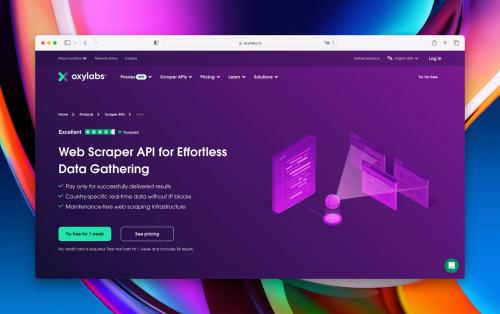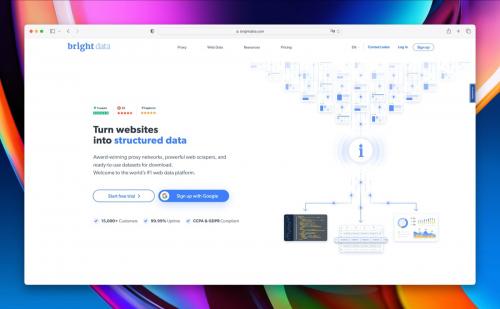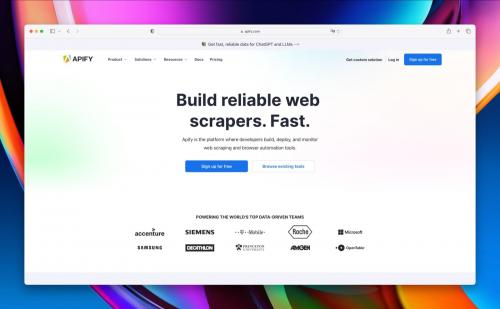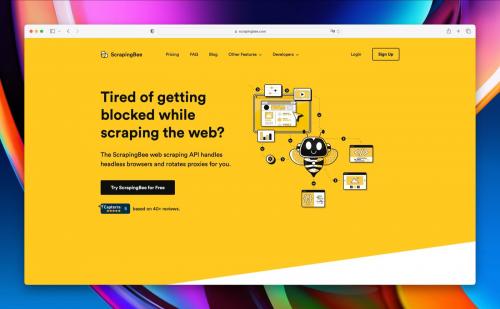Top 10 web scraping APIs you should try right now
- Top 10 web scraping APIs you should try right now
- Web scraping using API. A brief introduction to APIs ¶
- Rest API web scraping. What is scrapestack, and What Makes it Powerful for Web Scraping?
- Web scraping API free. Лучшие сервисы для веб скрапинга данных: топ-7
- Best web scraping APIs. 6 Best Web Scraping API Tools You Can Use
Top 10 web scraping APIs you should try right now
1. Apify
We’ll put our own product first because we believe it’s the best web scraping API you can use to extract website data in 2023.and we think you’ll agree
Thefacilitates scalable and efficient data extraction and management, streamlining the process of collecting information from websites and improving data reliability. It also provides access to a huge library of pre-built scrapers (called). Each Apify Actor is effectively a web scraping API that targets popular websites. They can be used with the default settings or as a starting point for custom scraping projects.currently offers 1,200+ different scraping tools.
The Apify API is designed to handle large volumes of data and a vast numbers of web pages without issues. The data can be stored and exported in different formats, such as Excel, CSV, JSON, and XML. It also includes utilities to allow developers to schedule, monitor, and manage long-running scraping jobs.is completely integrated into the platform and runs seamlessly in the background for most scraping tasks. Apify was designed by devs for devs, so you can fetch from a repository, push code from your local computer, or use our online code editor.
Apify scrapers can use all popular libraries, including Python, and JavaScript. Scrapy, Selenium, Playwright, and Puppeteer. Apify also maintains a state-of-the-art open-sourceand browser automation library for Node.js called.
Pros:
- Flexible and customizable: Apify allows users to define custom scraping tasks using either JavaScript or Python and offers a wide range of pre-built scrapers, enabling flexibility in data extraction.
- Extensive library of ready-to-use scrapers: Apify Store offers a variety of free and paid pre-built scraping solutions, that can be easily utilized to scrape data from popular websites without writing custom code.
- Full-featured cloud-based infrastructure: Apify users can enjoy the convenience of a cloud hosting infrastructure that eliminates the need for separate hosting solutions. This allows for easy storage, management, and sharing of software written in any programming language. In addition, Apify provides a comprehensive set of features for scheduling data extraction tasks and monitoring performance, ensuring a seamless and efficient web scraping experience.
- Pricing options: Apify provides a range of pricing plans, catering to different needs and project sizes. This includes a generous free tier, as well as various subscription options, making it well-suited for both small and large-scale web scraping projects. Apify also supports the use of web scraping education with a special discount for universities and researchers.
- Community: Apify has a large developer community active on Discord , which makes it easier for users to find solutions to their problems and connect with other like-minded web scraping enthusiasts.
- Unlimited free plan: Apify follows a freemium model, granting users immediate access to all its features, such as proxies and task scheduling. The only restriction is that free users are limited to a maximum monthly credit usage of $5.
- Multiple data formats: Apify supports various data formats, allowing users to obtain the extracted data in formats like JSON, CSV, or HTML, making it versatile for different data processing needs.
- Integrations: Apify offers an impressive range of pre-built external integrations, giving users access to a vast selection of services like Gmail, Google Drive, Make, Zapier, and more. By utilizing the Apify API and running scrapers on their platform, users can leverage these integrations for enhanced functionality and productivity.
Web scraping using API. A brief introduction to APIs ¶
In this section, we will take a look at an alternative way to gather data than the previous pattern based HTML scraping. Sometimes websites offer an API (or Application Programming Interface) as a service which provides a high level interface to directly retrieve data from their repositories or databases at the backend.
From Wikipedia,
" An API is typically defined as a set of specifications, such as Hypertext Transfer Protocol (HTTP) request messages, along with a definition of the structure of response messages, usually in an Extensible Markup Language (XML) or JavaScript Object Notation (JSON) format. "
They typically tend to be URL endpoints (to be fired as requests) that need to be modified based on our requirements (what we desire in the response body) which then returns some a payload (data) within the response, formatted as either JSON, XML or HTML.
A popular web architecture style calledREST(or representational state transfer) allows users to interact with web services viaGETandPOSTcalls (two most commonly used) which we briefly saw in the previous section.
For example, Twitter's REST API allows developers to access core Twitter data and the Search API provides methods for developers to interact with Twitter Search and trends data.
There are primarily two ways to use APIs :
- Through the command terminal using URL endpoints, or
- Through programming language specific wrappers
For example,Tweepyis a famous python wrapper for Twitter API whereastwurlis a command line interface (CLI) tool but both can achieve the same outcomes.
Here we focus on the latter approach and will use a Python library (a wrapper) calledwptoolsbased around the original MediaWiki API.
One advantage of using official APIs is that they are usually compliant of the terms of service (ToS) of a particular service that researchers are looking to gather data from. However, third-party libraries or packages which claim to provide more throughput than the official APIs (rate limits, number of requests/sec) generally operate in a gray area as they tend to violate ToS. Always be sure to read their documentation throughly.
Web Scraping using API: A Brief Introduction to APIs
APIs (Application Programming Interfaces) offer an alternative way to gather data, bypassing the need for pattern-based HTML scraping. Some websites provide APIs as a service, allowing direct access to their backend repositories or databases.
According to Wikipedia, an API is "a set of specifications, such as Hypertext Transfer Protocol (HTTP) request messages, along with a definition of the structure of response messages, usually in an Extensible Markup Language (XML) or JavaScript Object Notation (JSON) format."
APIs typically consist of URL endpoints that need to be modified based on our requirements, returning a payload (data) in JSON, XML, or HTML format. For example, Twitter's REST API provides access to core Twitter data, while the Search API offers methods for interacting with Twitter Search and trends data.
There are two primary ways to use APIs:
- Official APIs, which are compliant with the terms of service (ToS) of the service being accessed.
- Third-party libraries or packages, which may offer more throughput (rate limits, number of requests per second) but often operate in a gray area, potentially violating ToS. Always read the documentation thoroughly before using these libraries.
Using official APIs ensures compliance with ToS, while third-party libraries may offer more flexibility but require careful consideration of the potential risks involved.
Rest API web scraping. What is scrapestack, and What Makes it Powerful for Web Scraping?
The scrapestack API was built to offer a simple REST API interface for scraping web pages at scale without having to programmatically deal with geolocations, IP blocks, or CAPTCHAs. The API supports a series of features essential to web scrapings, such as JavaScript rendering, custom HTTP headers, various geo-targets, POST/PUT requests, and an option to use premium residential proxies instead of datacenter proxies. A great API to pair with this API is a geolocation with IP API.
Here is the reason why scrapestack have 2000+ satisfied customers:
- Millions of Proxies & IPs: scrapestack provides an extensive pool of 35+ million datacenter and residential IP addresses across dozens of global ISPs, supporting real devices, smart retries, and IP rotation.
- 100+ Global Locations: Chosen from 100+ supported global locations to send your web scraping API requests or simply use random geo-targets — supporting a series of major cities worldwide.
- Rock-Solid Infrastructure: Scrape the web at scale at an unparalleled speed and enjoy advanced features like concurrent API requests, CAPTCHA solving, browser support, and JS rendering.
- Free & Premium Options: If you are here to test the API without any commitments, scrapestack provides the Free Plan. If you ever need more advanced access, premium pricing plans start at $19.99 per month.
The scrapestack API is a product built and maintained by apilayer, an Austrian technology company aiming to build a variety of reliable programming interfaces (APIs) and make them affordable for developers and startups. Browse all available products here .
scrapestack powered by one of the most powerful web scraping engines on the market — offering the #1 solution for all your scraping requirements in one place. This article outlines in detail diverse API endpoints, available options, and tutorials with Node.js and other platforms (Postman and RAD Studio REST Debugger).
Web scraping API free. Лучшие сервисы для веб скрапинга данных: топ-7
Рассказываем, что такое веб скрапинг, как применяют данные полученные этим способом, и какие сервисы для веб скрапинга существуют на рынке.
В октябре 2020 года Facebook подал жалобу в федеральный суд США против двух компаний, обвиняемых в использовании двух вредоносных расширений для браузера Chrome. Эти расширения позволяют выполнять скрапинг данных без авторизации в Facebook, Instagram, Twitter, LinkedIn, YouTube и Amazon.
Оба расширения собирали публичные и непубличные данные пользователей. Компании продавали эти данные, которые затем использовались для маркетинговой разведки.
В этой статье мы разберемся, как выполнять скрапинг данных легально, и расскажем про семь сервисов для веб скрапинга, которые не требуют написания кода. Если вы хотите выполнять скрапинг самостоятельно, прочитайтеинструментов и библиотек для скрапинга.
Что такое скрапинг данных?
Скрапинг данных или веб скрапинг – это способ извлечения информации с сайта или приложения (в понятном человеку виде) и сохранение её в таблицу или файл.
Это не нелегальная техника, однако способы использования этих данных могут быть незаконными. В следующем
Как используют эти данные
Веб скрапинг имеет широкий спектр применений. Например, маркетологи пользуются им для оптимизации процессов.
1. Отслеживание цен
Собирая информацию о товарах и их ценах на Amazon и других платформах, вы можете следить за вашими конкурентами и адаптировать свою ценовую политику.
2. Рыночная и конкурентная разведка
Если вы хотите проникнуть на новый рынок и хотите оценить возможности, анализ данных поможет вам сделать взвешенное и адекватное решение.
3. Мониторинг соцсетей
YouScan, Brand Analytics и другие платформы для мониторинга соцсетей используют скрапинг.
4. Машинное обучение
С одной стороны, машинное обучение и AI используются для увеличения производительности скрапинга. С другой стороны, данные, полученные с его помощью, используют в машинном обучении.
Интернет — это важный источник данных для алгоритмов машинного обучения.
5. Модернизация сайтов
Компании переносят устаревшие сайты на современные платформы. Для того чтобы быстро и легко экспортировать данные, они могут использовать скрапинг.
6. Мониторинг новостей
Скрапинг данных из новостных сайтов и блогов позволяет отслеживать интересующие вас темы и экономит время.
7. Анализ эффективности контента
Блоггеры или создатели контента могут использовать скрапинг для извлечения данных о постах, видео, твитах и т. д. в таблицу, например, как на видео выше.
Данные в таком формате:
- легко сортируются и редактируются;
- просто добавить в БД;
- доступны для повторного использования;
- можно преобразовать в графики.
Сервисы для веб скрапинга
Скрапинг требует правильного парсинга исходного кода страницы, рендеринга JavaScript, преобразования данных в читаемый вид и, по необходимости, фильтрации. Поэтому существует множество готовых сервисов для выполнения скрапинга.
Вот топ-7 инструментов для скрапинга, которые хорошо справляются с этой задачей.
1. Octoparse
Octoparse — это простой в использовании скрапер для программистов и не только. У него есть бесплатный тарифный план и платная подписка.
Особенности:
- работает на всех сайтах: с бесконечным скроллом, пагинацией, авторизацией, выпадающими меню, AJAX и т.д.
- сохраняет данные в Excel, CSV, JSON, API или БД.
- данные хранятся в облаке.
- скрапинг по расписанию или в реальном времени.
- автоматическая смена IP для обхода блокировок.
- блокировка рекламы для ускорения загрузки и уменьшения количества HTTP запросов.
- можно использовать XPath и регулярные выражения.
- поддержка Windows и macOS.
- бесплатен для простых проектов, 75$/месяц — стандартный, 209$/месяц — профессиональный и т. д.
2. ScrapingBee
ScrapingBee Api использует «безголовый браузер» и смену прокси. Также имеет API для скрапинга результатов поиска Google.
Особенности:
- рендеринг JS;
- ротация прокси;
- можно использовать с Google Sheets и браузером Chrome;
- бесплатен до 1000 вызовов API, 29$/месяц — для фрилансеров, 99$/месяц — для бизнеса и т.д.
3. ScrapingBot
ScrapingBot предоставляет несколько API: API для сырого HTML, API для сайтов розничной торговли, API для скрапинга сайтов недвижимости.
Best web scraping APIs. 6 Best Web Scraping API Tools You Can Use
We gathered 6 best web scraping API tools you can use for your needs. We also included their pros and cons so that you can decide which one works best for you quickly.
Here are the best web scraping API tools in 2023:
1. Oxylabs Scraper API

Oxylabs is a great solution for individuals and businesses looking to collect public data and access premium proxies effortlessly. It provides ready-to-use code samples and multiple language support, 100M+ Residential proxies, AI-powered web unblocker, proxy manager, mobile proxies, and more.
Pros:
- Paying only per successful results
- Easy access to localized content
- 102M+ proxy pool
- Data delivery to your cloud storage bucket (AWS S3 or GCS)
- Free trial for one week
Cons:
- Can be complex to set up
2. Bright Data

BrightData (formerly Luminati) is a web scraping and data collection platform that provides a range of tools and features, such as residential proxies, data unblocking, and advanced scraping algorithms.
Some of the pros and cons of BrightData include:
Pros:
- Offers a wide range of tools and features
- Provides a high level of data quality and accuracy
- Provides excellent customer support
Cons:
- Can be more complex to set up and use
3. Apify

Apify is a web scraping and automation platform that allows users to extract data from websites, automate workflows, and create custom APIs. It provides a wide range of tools and features, such as pre-built scrapers, custom scrapers, and an intuitive user interface.
Some of the pros and cons of Apify include:
Pros:
- Easy to use, even for beginners
- Provides pre-built scrapers for popular websites
- Allows users to create custom scrapers
- Provides a wide range of tools and features
Cons:
- Can be expensive for larger datasets
- Some users have reported issues with customer support
- Apify offers both free and paid plans, with prices starting at $49/month.
4. ScrapingBee

ScrapingBee is a web scraping API tool that provides a reliable and scalable solution for extracting data from websites. It offers a range of features, such as rotating proxies, JavaScript rendering, and custom headers.